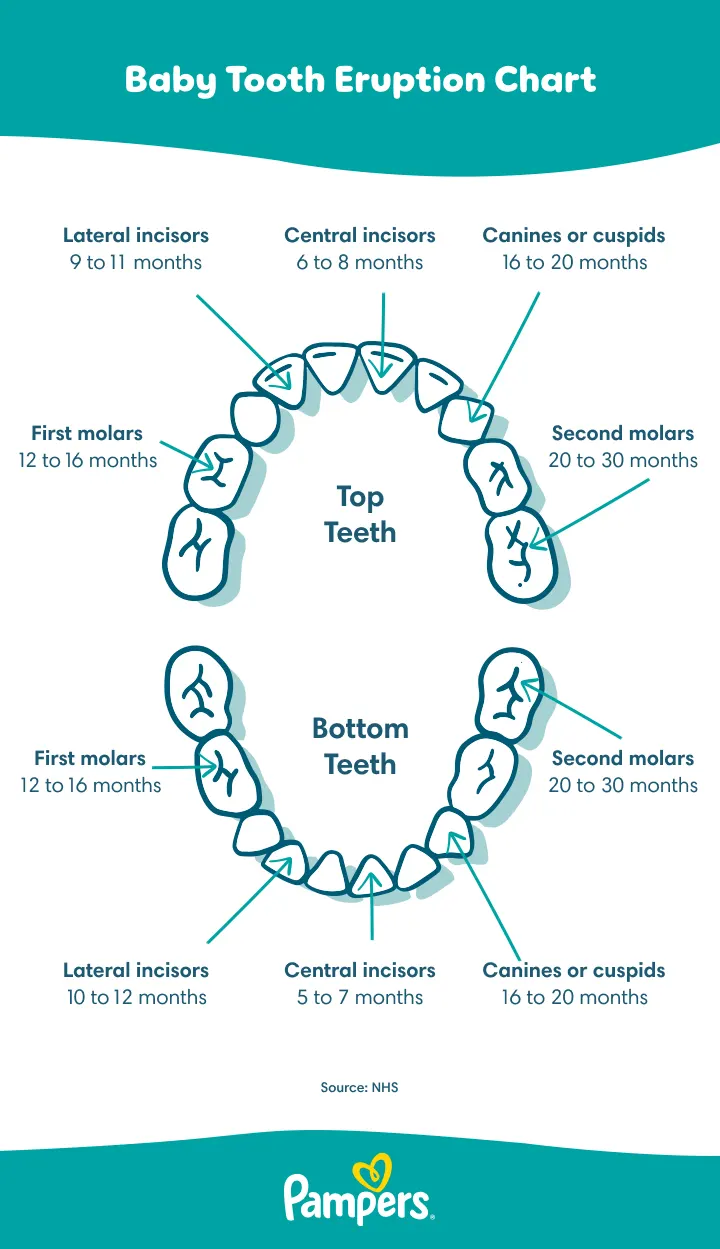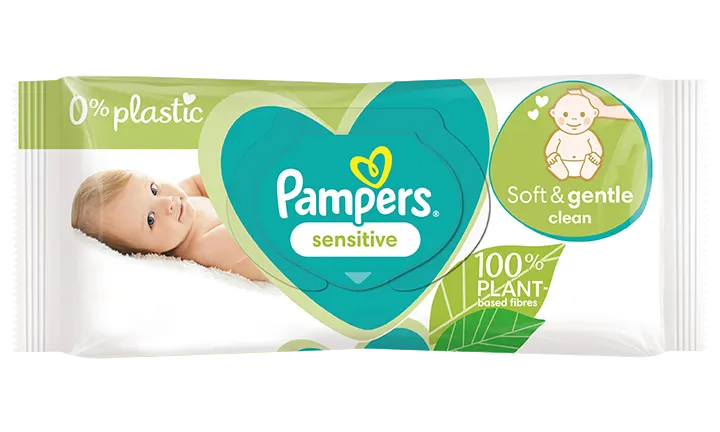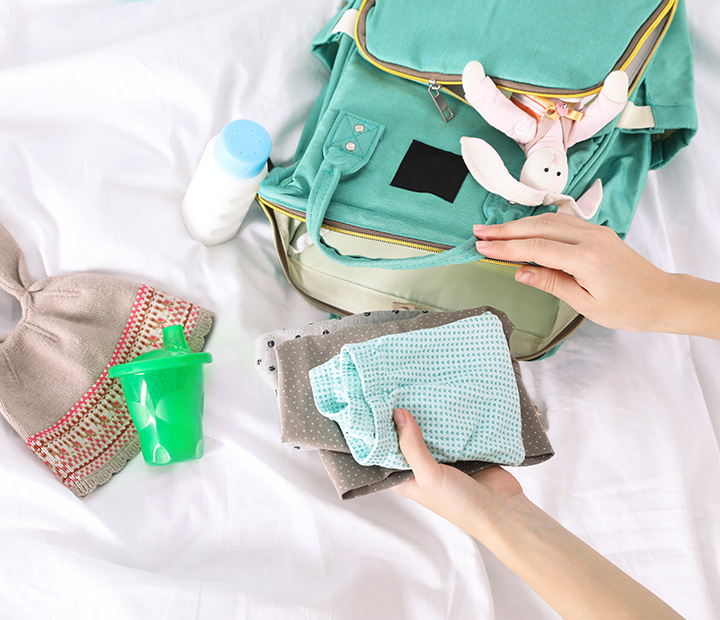Baby Teething Symptoms: What to Expect
Your baby’s first tooth and those heart-melting toothy grins are moments to cherish. If you’re wondering ‘Is my baby teething?’, it’s worth knowing that the timing and age of teething may vary greatly. Keep reading to learn about when your baby might start teething, the common signs of baby teething, how long it may last and helpful tips to soothe your little one once they reach this important milestone.
When Do Babies Start Teething?
Teething typically begins between six and twelve months of age, although every baby is different. In some rare cases, a baby may even be born with a tooth already erupted or have one come through during their first few weeks of life.
Look out for signs of teething, such as tender gums, dribbling or gnawing on a fist or finger, which may indicate that you’ll soon be seeing a tooth emerge.
How Long Does Teething Last?
Every baby is unique and while some little ones may breeze through teething with minimal discomfort, others might experience more noticeable symptoms. On average, the baby teething age starts around six months and continues until your child has their full set of 20 primary teeth, usually between 20 and 30 months old.
If your baby does experience discomfort during this time, you’ll find several ways to help soothe their teething symptoms and make them more comfortable throughout our guide.
How Many Baby Teeth Will Appear in Total?
Your little one’s first set of teeth, often called primary, milk or baby teeth, will eventually include 20 teeth in total. By the time they’re about two-and-a-half to three years old, their full set of baby teeth should have emerged. Around the age of six or seven, these milk teeth will begin to fall out, making way for their permanent teeth, also known as secondary teeth. This transition takes several years, so your child will have a mix of milk and permanent teeth for some time.
In Summary Your child’s first set of teeth are called baby teeth, milk teeth or primary teeth:
|
Teething Timeline: From First Tooth to Full Smile
When each tooth comes in and in what order varies from child to child, but a baby teething chart may give you a general idea of the teething timeline by age.
Bottom Teeth
Central incisors (the two front teeth): 5 to 7 months
Lateral incisors (the two teeth on either side of the front teeth): 10 to 12 months
Canines or cuspids (the two sharp, pointy teeth on either side of the lateral incisors): 16 to 20 months
First molars (the four back teeth used to grind food): 12 to 16 months
Second molars (the four back teeth that fill in the last gaps): 20 to 30 months.
Top Teeth
Central incisors (the two front teeth): 6 to 8 months
Lateral incisors (the two teeth on either side of the front teeth): 9 to 11 months
Canines or cuspids (the two sharp, pointy teeth on either side of the lateral incisors): 16 to 20 months
First molars (the four back teeth used to grind food): 12 to 16 months
Second molars (the four back teeth that fill in the last gaps): 20 to 30 months.
Signs and Symptoms of Teething
Sometimes a tooth may appear without any noticeable symptoms, while in other cases signs of baby teething may start three to four days before the tooth becomes visible. As the baby teeth grow and break through the gums, teething symptoms might include:
Irritability. Your little one might seem a little fussier and may cry more than usual.
Disturbed sleep. Discomfort or pain from teething may cause your baby to wake more often during the night.
More dribbling. It is common for teething babies to dribble more than usual. Extra saliva may help soothe their tender gums.
Chewing on objects. Teething babies often gnaw on toys, teething rings or even their own fingers to relieve the pressure on their gums. Chewing on something firm may massage their gums and ease discomfort as the tooth erupts.
Sore, swollen gums. When teething, your baby’s gums may be tender, red and swollen in the area where a tooth is coming through.
Low-grade temperature. Teething may cause a mild increase in temperature but is unlikely to cause a fever. If your baby has a temperature of 38 degrees Celsius or higher or seems very unwell, contact your GP or healthcare provider to check for other causes.
What’s Normal and What’s Not During Teething
mild discomfort and irritability, red swollen gums, drooling, a slight rise in temperature and chewing on fingers and objects. However, it’s important to distinguish normal symptoms from those that may indicate something else is going on. Here are some signs that your baby’s symptoms are from something other than teething:
Fever. Experts emphasise that teething is unlikely to cause a fever of 38 degrees Celsius or higher. Consult your GP if your baby’s temperature rises.
Inconsolable crying. Persistent or severe crying may indicate an issue beyond teething, such as colic.
Lethargy. Difficulty waking or extreme tiredness may need urgent medical attention.
Diarrhoea or widespread rash. These are not typical teething symptoms and should be checked by a GP.
Face rash. While dribbling may lead to rashes around the mouth, more widespread or severe rashes could suggest other conditions, such as an allergic reaction or skin irritation.
If in doubt, always consult your GP or health visitor.
In Summary A baby's teething symptoms may include:
|
How to Help Soothe Your Teething Baby: Teething Remedies
Teething may be uncomfortable for some babies, but there are simple ways to help soothe their discomfort and provide baby teething relief:
Teething rings. Let your baby chew on a teething ring to massage their gums. Cooling it in the fridge may provide extra relief, but avoid freezing it, as this may make it too hard.
Gum massage. Gently rub your baby’s gums with a clean finger to ease soreness.
Cool foods. If your baby is eating solids, offer chilled fruit or yoghurt to soothe their gums.
Wipe away drool. Use a soft cloth to keep your baby’s chin dry and prevent irritation from excessive drooling.
Caring for Your Baby’s New Teeth: Essential Tips
Caring for your baby’s teeth is vital as soon as the first one appears. These milk teeth will need to last for several years and play a key role in chewing, speech development and guiding the permanent teeth into place. Establishing good dental hygiene early on sets the foundation for lifelong healthy teeth and gums.
Preventing cavities and tooth decay in baby teeth is just as important as it is for adult teeth. Decay in baby teeth can affect the permanent teeth that follow and may lead to other dental issues, such as pain and infections. Read on to discover when to start brushing your baby’s teeth and more care tips.
Brushing Your Baby’s Teeth
Regular brushing is essential as soon as the first tooth comes through. Follow these steps to care for your little one’s teeth.
Brush twice a day. Gently clean your baby’s teeth in the morning and before bedtime. Always brush after any sugary foods or drinks.
Use the right toothpaste. Apply a smear of fluoride toothpaste (no more than a grain of rice) to a soft baby toothbrush. For children under three, make sure the toothpaste has at least 1,000 ppm (parts per million) fluoride.
Clean thoroughly. Brush all tooth surfaces, including the front, back and sides. The direction of brushing doesn’t matter as long as all areas are reached.
Help until they are older. Brush your child’s teeth for them until they can do it properly on their own, usually by the age of seven or eight.
Make toothbrushing fun by turning it into a game or using songs to encourage your little one to engage.
Diet
What your baby eats and drinks plays a significant role in their dental health. To protect their teeth:
Limit sugary drinks like fruit juice and fizzy drinks. Water and milk are the best options.
Limit sugary and sticky foods like sweets, toffee and dried fruit, which may stick to teeth and cause decay.
Do not let your baby fall asleep with a bottle containing milk, formula, juice or any sweetened drink, as this may cause tooth decay.
Encourage healthy snacks like fresh fruits, vegetables and cheese to promote good oral health.
Dental Checkups
Taking your baby to the dentist early is key to ensuring their teeth and gums stay healthy. The NHS recommends booking their first dental visit as soon as their first tooth appears or by their first birthday. Regular dental checkups will help detect and prevent any potential problems.
In Summary Caring for your baby’s new teeth:
|
When to See Your Baby’s GP
If your baby has symptoms like a fever, severe irritability or diarrhoea and you’re unsure if it’s teething or something else, consult your GP or health visitor.
Seek immediate advice if your baby:
has a high fever (38 degrees Celsius or higher)
is unusually drowsy or difficult to wake
cries inconsolably for a prolonged period
shows other unusual symptoms like diarrhoea or a widespread rash.
For severe teething discomfort, your GP may suggest safe pain relief. Avoid using teething gels to numb the gums, as they may be unsafe. If your baby has a chipped or broken tooth, contact your dentist promptly. When in doubt, always seek advice to ensure your baby’s well-being.
Interesting Facts About Baby Teeth
Curious about your little one’s baby teeth? Here are some interesting facts to give you a deeper understanding of those pearly whites:
On average, about four teeth erupt every six months during teething.
Girls’ teeth often erupt earlier than boys.
Bottom teeth usually appear before their upper counterparts of the same type.
Teeth typically erupt in symmetrical pairs, meaning the same tooth on each side of the jaw comes through at roughly the same time.
Milk teeth are smaller and whiter than the permanent teeth that will replace them.
From around the age of four, your child’s face and jaw will grow, creating gaps between their milk teeth. This is normal and prepares the mouth for larger adult teeth.
By around age seven or eight, adult teeth (secondary teeth) will start to appear and your child will have a mix of baby and adult teeth until all 28 to 32 permanent teeth are in place by their late teens or early twenties.
Understanding your baby’s teeth may help you navigate the teething process and prepare for the changes ahead.
FAQS AT A GLANCE
Teething signs include irritability, disrupted sleep, drooling, chewing on objects and red, swollen gums. These symptoms usually appear a few days before a tooth emerges. If you’re unsure whether it’s teething or something else related to their symptoms, consult your GP or health visitor.
The Bottom Line
Teething may be challenging, but those baby teeth are essential for chewing and enjoying nutritious foods that support your baby’s growth. If you’re eagerly awaiting that first tooth, rest assured it will arrive soon and more will follow. Each new tooth is an exciting surprise.
Taking good care of your baby’s tiny milk teeth will ensure they stay healthy and pave the way for their permanent set of teeth later in life.
Don’t forget to download the Pampers Club app and earn exclusive rewards with each Pampers purchase you make!
How We Wrote This Article The information in this article is based on the expert advice found in trusted medical and government sources, such as the National Health Service (NHS). You can find a full list of sources used for this article below. The content on this page should not replace professional medical advice. Always consult medical professionals for full diagnosis and treatment.
Join Pampers Club and get:







